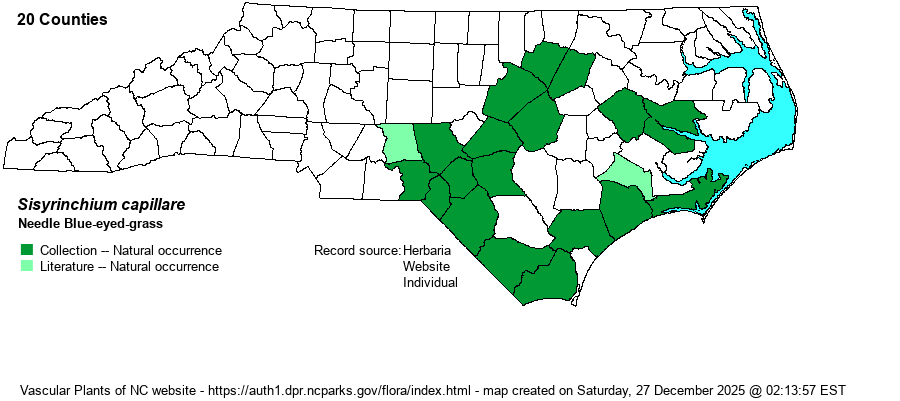| Author | Bicknell | |
| Distribution | Essentially the southern and central Coastal Plain and adjacent areas in the extreme eastern Piedmont. Ranges west only to Franklin, Wake, Montgomery, and Richmond counties. Note that this species had been included within S. albidum in RAB (1968), and thus the Coastal Plain and easternmost Piedmont records on the S. albidum map in RAB now refer to S. capillare.
This species has a rather small range, limited just to southeastern VA, the eastern halves of the Carolinas, and coastally in GA and reportedly northeastern FL. | |
| Abundance | Uncommon to infrequent in the NC range, but may be locally numerous in some managed areas near the coast. Rare in the eastern edge of the Piedmont. It is likely that many species of blue-eyed-grasses have been under-collected in the state, as range maps for many are not solidly populated but have many holes, such as seen on this species' map. | |
| Habitat | In the Coastal Plain, it is mainly found in pine flatwoods and savannas, and also in other damp but sunny ground. In the Sandhills it occurs in upper ecotones of streamhead pocosins, as well as moist to dryish pine savannas. | |
| Phenology | Blooms from March into June, and fruits from May into June. | |
| Identification | This is the most slender and delicate of our blue-eyed-grasses, probably noticeable on first sight. It has a flowering stem and leaves that only reach 8-10 inches tall; these parts are glaucescent and thus pale. The leaves are almost needle-like and flexible, and not stiff like a few other species. In addition, the flowering stem is extremely thin and not winged, barely 1/20-inch wide. The specific epithet refers to the capillary leaves curling as they age and then turning gray, with many leaf bases persisting as fibers (no fibers in S. albidum). Otherwise, the plant has an unbranched stem with a few flowers at the nodes where the bracts occur. The flowers are whitish or very pale blue, as in S. albidum, and about 1/2-inch across, like most others in the genus. This is the blue-eyed-grass most likely to be found in our managed savannas and flatwoods along the southern coast. Because it is so wiry, it might be overlooked as Carolina Wiregrass (Aristida stricta), or simply not noticed at all, unless or until you see the whitish flowers on the end of the stem. | |
| Taxonomic Comments | As mentioned above, some older references included it within S. albidum, as done in RAB (1968). Though nearly all references do treat it now as a good species, NatureServe disturbingly has never given it a Global Rank! As the GNR implies Globally Not Ranked, this website is proposing a Global Rank of G3G4, to be conservative, as it is known from perhaps just 35-40 counties in its overall range. See Sorrie et al. (2012) for a discussion of the "albidum complex.
| |
| Other Common Name(s) | None | |
| State Rank | S3 | |
| Global Rank | GNR [G3G4] | |
| State Status | | |
| US Status | | |
| USACE-agcp | FACW link |
| USACE-emp | FACW link |

